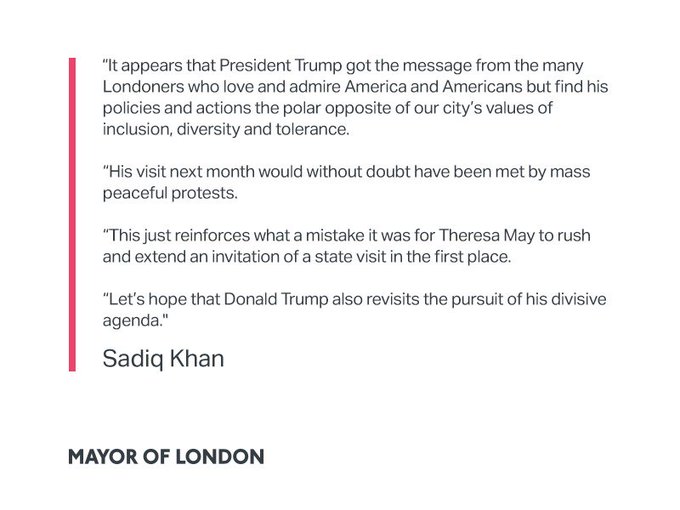The following article by Willa Frej was posted on the Huffington Post website January 12, 2018:
He blames Obama for the move, even though it was first planned under Bush.
LONDON ― President Donald Trump offered a classically Trumpian explanation for why he canceled his upcoming trip to the U.K.: the construction of a new U.S. embassy in the British capital represents a bad deal, and he wants nothing to do with it.
“Reason I canceled my trip to London is that I am not a big fan of the Obama Administration having sold perhaps the best located and finest embassy in London for ‘peanuts,’ only to build a new one in an off location for 1.2 billion dollars,” he tweeted late Thursday. “Bad deal. Wanted me to cut ribbon-NO!”
While he’s correct that the construction of the new building was an unusually costly undertaking, most of his assertions, including placing the blame on President Barack Obama, majorly miss the mark, and lack decades of nuance and historical context.
The decision to move the embassy move predated Obama.
The decision to move the embassy from London’s Grosvenor Square actually took place during President George W. Bush’s tenure, though construction on the new site, located across the Thames river in an area called the Nine Elms Opportunity Zone, began in 2013.

“This has been a long and careful process,” Robert Tuttle, then-U.S. ambassador to Britain, said in October 2008. “In the end, we realized that the goal of a modern, secure and environmentally sustainable embassy could best be met by constructing a new facility.”
The U.S. didn’t own the land the old embassy sits on.
The Duke of Westminster owns the plot of land in Mayfair where the current embassy is located. It’s created somewhat of a sticky situation for the U.S., which owns most of the land that accompanies its embassies around the world.
Legend has it that when construction finished on the Eero Saarinen-built structure in 1960, the two countries agreed to a long-term lease that cost the U.S. one golden peppercorn annually.
The Duke reportedly refused to sell the land to the Americans, once even joking that he would only do so if the U.S. promised to return land belonging to his family that was confiscated during the war for U.S. independence.
Qatar’s sovereign wealth fund bought the building in 2009, winning approval in 2016 to turn the property into a luxury hotel.
It’s not as simple as the embassy being bought for “peanuts.”
The price tag on the construction of the new building, about $1 billion, makes it the most expensive project of its kind. But, as the embassy’s website notes, the U.S. managed to fund it entirely through the sale of other U.S.-owned properties in London, including, according to The Washington Post, the current embassy. So, while we don’t know exactly how much the U.S. gained from the sales, we do know that the new construction happened at no cost to U.S. taxpayers.
The embassy’s current location is hardly, as Trump claimed, “the finest.”
The current embassy’s location in a busy square makes it difficult to secure, and attempts to do so weren’t popular with the neighbors. The U.S. spent £8 million (about $11 million) on security upgrades following the September 11, 2001, attacks, because local residents protested having to live near what they felt was a terror target.
“We will be sorry to see the U.S. embassy leave as the current security arrangements we negotiated are working well,” Robert Davis, deputy leader of the Westminster City Council, said in 2008. “But we understand their desire to be in a more secure compound.
The highly congested area also subjected some U.S. diplomats to a congestion tax, which they seemingly have refused to pay. People who drive through central London on weekdays are required to pay a fee in an effort to cut down on traffic. According to official figures, embassy staff owe about $15 million to the city.
The new embassy is hardly in an “off location.”
Located near the river on London’s South Bank, the new Nine Elms location actually fulfils one of the core missions of an embassy ― a connection with the given country’s government.
“As the United Kingdom is our best friend and best ally, we wanted to be as close to parliament and government buildings as the current site and we have achieved that,” Tuttle said in the same 2008 statement. The new building is walking distance from London’s MI6 foreign intelligence headquarters.
The move also appears to be creating big benefits for the surrounding community.
“The embassy has been a magnet for new investment and a vital catalyst for a regeneration program which is delivering tens of thousands of jobs and homes,” local councillor Ravi Govindia said.
The fear of protests could have also been part of Trump’s calculation.
There may be more to Trump’s decision that he isn’t letting onto. Namely, a trip to London could have done further damage to the president’s public image.
“His visit next month would without doubt have been met by mass peaceful protests,” London Mayor Sadiq Khan said Friday in a statement. “Many Londoners have made it clear that Donald Trump is not welcome here while he is pursuing such a divisive agenda. It seems he’s finally got that message.”
In fact, tens of thousands of people have already shown interest in a protest that was scheduled in anticipation of Trump’s visit.
Trump’s expected visit had been laced with controversy from the start, given the rollercoaster relationship he has fostered with the British government. He’s consistently denigrated Prime Minister Theresa May and Khan over their handling of terrorism in the U.K. May, in turn, criticized him for retweeting a series of Islamophobic videos shared by a controversial British far-right activist.
View the post here.

